Member of the Indian Arts and Crafts Association Turquoise Beads
QUESTION:
My sister taught school on the reservation in Pine Ridge (Porcupine) nearly
20 years agone. She will be l this yr. I am looking to buy her turquoise jewelry. I'd similar to know it's authentic and made by the Indians. She would hold this every bit being very special. I sympathise that some jewelry has tribes' names inscribed on the back. Can you requite some reputable stores or web sites that I tin look at and purchase. I would exist particularly interested in Lakota, Sioux.
~Submitted by Kathy C.
ANSWER:
The Lakota Sioux are non generally known for making turquoise jewelry. Beadwork and quillwork are more than mutual crafts for a person from the Lakota Sioux tribe. I am certain there must be some individuals who are silversmiths with Lakota heritage, (although I don't personally know any), but this group of tribes in general is not known for this art form.
Most, if not all, of the popular styles of Native American turquoise jewelry originated in the American Southwest.
Navajo jewelry
 The Navajo were the beginning commercial silversmiths in the American Southwest and produce the largest and flashiest jewelry with lots of free class natural stones and cabachons made of turquoise, coral, and other semi-precious gem stones and elaborate silver piece of work. They are the virtually copied past non-native american jewelry producers.
The Navajo were the beginning commercial silversmiths in the American Southwest and produce the largest and flashiest jewelry with lots of free class natural stones and cabachons made of turquoise, coral, and other semi-precious gem stones and elaborate silver piece of work. They are the virtually copied past non-native american jewelry producers.
While the Navajo have had turquoise jewelry since prehistoric times, silverwork was non a traditional Navajo arts and crafts, simply became popular in the early reservation era, when Navajo artists realized they could support themselves selling this craft form to the tourist trade. Originally, silverish coins or household objects such as silver candle sticks or silver teapots were frequently melted down for the argent used in their jewelry.
Atsidi Sani is unremarkably credited with being the beginning Navajo silversmith, in 1868. A full line of silverish jewelry existed throughout the Navajo reservation by the 1880s.
Very shortly later Atsidi Sani began silversmithing, the arts and crafts spread across the area. He taught his sons and they taught others. The arts and crafts appeared in Zuni effectually 1872. Atsidi Chon (Ugly Smith) taught silversmithing to his close Zuni friend, Lanyade. Information technology is said that Lanyade paid Atsidi Chon one practiced horse for his instruction.
While on Hopi First Mesa at Sichomovi, Lanyade taught the first Hopi silversmith, Sikyatala.
Indian jewelry factories
At that place are a number of businesses in the U.S. southwest who employ Navajo people to mass produce "Indian" jewelry in factories. The casual buyer may non be able to tell handcrafted jewelry from machine fabricated, or genuine turquoise from plastic.
In the last x to twenty years, there has been a alluvion of imitations made in the Philippines and Taiwan that look identical to american indian-made argent jewelry. Sometimes even the experts can be fooled.
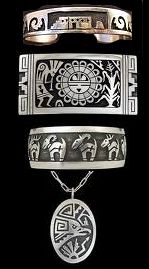 The Navajo also exercise fetish carvings and make smaller fetishes into fetish necklaces.
The Navajo also exercise fetish carvings and make smaller fetishes into fetish necklaces.
Hopi Indian Jewelry
The Hopi tend to produce stylized piece of work using the "overlay" process where one sheet of silvery with "cut out" designs is laid over a plain sheet of identical design and shape. The recessed area is then left unpolished, or "blackened" during the finishing procedure.
Zuni Indian Jewelry
 The Zuni are known for several styles of craftsmanship. The almost common is stone and trounce inlay, in which shells and slices of stone are individually cut and prepare in silvery jewelry to fit closely together in specific patterns.
The Zuni are known for several styles of craftsmanship. The almost common is stone and trounce inlay, in which shells and slices of stone are individually cut and prepare in silvery jewelry to fit closely together in specific patterns.
 The Zuni are also known for needlepoint (narrow stones pointed on both ends) and petit indicate (any other small cut stone shape such equally oval, teardrop etc.) gem work, which consists of dozens of uniformly cut stones that are gear up in traditional patterns, which are set up on top of the silverish instead of being fitted together and inlaid to grade the pattern.
The Zuni are also known for needlepoint (narrow stones pointed on both ends) and petit indicate (any other small cut stone shape such equally oval, teardrop etc.) gem work, which consists of dozens of uniformly cut stones that are gear up in traditional patterns, which are set up on top of the silverish instead of being fitted together and inlaid to grade the pattern.
 The Zuni are also known for their carvings of animals and birds called "fetishes." These are available either individually equally table top sized sculptures, or in strings of small carvings called "fetish necklaces."
The Zuni are also known for their carvings of animals and birds called "fetishes." These are available either individually equally table top sized sculptures, or in strings of small carvings called "fetish necklaces."
Santo Domingo Pueblo Jewelry
 Santo Domingo Pueblo is one of the largest, near populous and most prosperous of the Rio Grande Pueblos, now located in the country of New Mexico. Much Santo Domingo jewelry is like to bequeathed Pueblo or Anasazi jewelry discovered by archaeologists.
Santo Domingo Pueblo is one of the largest, near populous and most prosperous of the Rio Grande Pueblos, now located in the country of New Mexico. Much Santo Domingo jewelry is like to bequeathed Pueblo or Anasazi jewelry discovered by archaeologists.
 Santo Domingo is likewise the leading domestic producer of the tiny handmade beads known every bit heishi, which information technology frequently markets to other tribes. (These are also mass produced in Asia.) Many Santo Domingo artists besides do inlay piece of work on beat out bases.
Santo Domingo is likewise the leading domestic producer of the tiny handmade beads known every bit heishi, which information technology frequently markets to other tribes. (These are also mass produced in Asia.) Many Santo Domingo artists besides do inlay piece of work on beat out bases.
The Santo Domingo artists are best known for strung necklaces made of heishi, frequently intersperced with drilled free form turquoise nuggets, coral, or bird fetishes. The Santo Domingo practise non use any other animal fetishes. Only 1 style of bird fetish, which is sacred to them, is used in their designs.
Plains Indian Jewelry
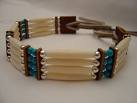 Plains Indian jewelry is usually not centered around silverwork. Chokers made from buffalo horn and bone hairpipe beads, multi-strand wampum necklaces (such as the one worn by Chief Joseph in many photographs), conch shell and abalone necklaces and earrings,
Plains Indian jewelry is usually not centered around silverwork. Chokers made from buffalo horn and bone hairpipe beads, multi-strand wampum necklaces (such as the one worn by Chief Joseph in many photographs), conch shell and abalone necklaces and earrings, 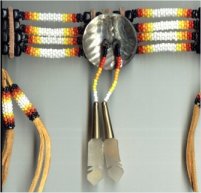 intricate quillwork using dyed or natural porcupine quills to form the blueprint, and intricate beadwork patterns using tiny seed chaplet are more traditional for Plains tribe artisans.
intricate quillwork using dyed or natural porcupine quills to form the blueprint, and intricate beadwork patterns using tiny seed chaplet are more traditional for Plains tribe artisans.
 Beadwork rosettes, and jewelry containing traditional indian beadwork patterns are frequently imported from Taiwan and China, and bone chokers are ofttimes imported from Bharat and China.
Beadwork rosettes, and jewelry containing traditional indian beadwork patterns are frequently imported from Taiwan and China, and bone chokers are ofttimes imported from Bharat and China.
In the one-time days, the Plains Indians made hairpipe beads from bird bones and the minor leg bones of animals such as the coyote. They were fourth dimension consuming to brand, and costly to trade for, so the number of rows in a hairpipe ornamentation represented the status or wealth of the wearer.
Today, virtually all os and horn hairpipe beads are fabricated from water buffalo bones and horns, and are imported from India and China. Both native and non-native artists use the same hairpipe beads in their piece of work.
How to spot Asian, Phillippine, Chinese and US fabricated false/simulated Native American jewelry
Jewelry Appearance
Is the jewelry well crafted? Are images clear, lines unwavering? Are stones well-cut, uniform in size and secure in their settings? If the blueprint is stamped, is the design clear and fifty-fifty? Stamped designs which bear witness on the inside of the jewelry are oft mechanically stamped.
Is the artist's 'hallmark' stamped on the jewelry? Both Indian and not-indian artists use a hallmark to identify their work. The hallmark stamp belongs to the individual artist, not a particular tribe. This may be a full name, initials, or a symbol. Not all artists sign their piece of work, and many artists only sign their exceptionally good quality work, while not signing less perfect pieces.
Hallmarks are a style of identifying the artist, time period, metallic content or other related information. Hallmarks alone practise non provide positive proof that yous have a highly sought afterward designer's work, represented by the hallmark. These marks tin can exist copied and duplicated just like a signature, and can represent multiple people when just initials are used.
Having a certain hallmark doesn't guarantee actuality or that it is definitely handmade by any ane person. Hallmarks are only 1 fashion of identifying an particular and who designed it. But proceed in mind that they tin can be forged. For a small fee, anyone can have a stamp made with whatever symbol they want.
The only way you tin actually know for certain is if you watch the artist really make the slice. In practicality, about the only thing yous can do is to know your seller or purchase from a reputable dealer who has been recommended from multiple sources.
Jewelry Materials
If jewelry is fabricated of silver, is it marked Sterling? In the US, the police force requires a piece of jewelry made from precious metals weighing more than 2 grams to accept this mark.
Sterling Silver, or .925 Silver is the standard used in the jewelry industry. Since pure silver is too soft for standard jewelry work, copper is added to the silverish alloy to generate the required mechanical strength. Sterling Argent alloy contains 92.five% Silvery and 7.five% Copper.
.999 Silver, or fine Silver, is pure silver or more accurately 99.9% silver, considering no metal is e'er completely pure. It is a very soft silverish metallic used generally in wire jewelry and stone wrapping, considering it bends very easily.
Look for a .925 postage on new items that are small. Native American silversmiths commonly stamp their Sterling Silver jewelry with a stamp that says Sterling , IF the item is large enough to have room for the total word. If it is stamped .925 or SS , it is less likely to exist Native American made because the traditional stamps say "Sterling." However, on minor items, such as rings, where there is little room to stamp anything, the shorter .925 or SS postage may be used by both native and non-native artists. Then, equally y'all can see, this test gets very disruptive.
Finding pieces stamped .925 or SS instead of Sterling isn't proof that they came from outside the US, or are not Native American fabricated. Only, if you have other reasons to feel suspicious, this might be some other indicator.
Older, genuine vintage Native American jewelry volition ofttimes have no hallmark or postage of any kind, and sometimes newer silver jewelry doesn't, either, but this is non the norm. Because information technology is a stiff selling bespeak, most modern artists will postage their silverish jewelry.
When 'silver' doesn't actually mean silver
Items marketed as "German silver," "Mexican silver," "Alpaca Argent," "Nickel Silverish," or "Tibetan silver" contain little or no existent silver metallic. Except for Tibetan silvery, these are all terms for compounds of nickel and/or copper and/or zinc type alloys. However, these alloys are oft stronger than sterling silverish and then they wear well for daily use, and require less polishing to retain their shininess, and await very similar to sterling silvery. They won't rust or plow your finger green, like some "plated" jewelry can on some people. "Plaited" argent is usually a sparse layer of a rhodium alloy over a cadre of brass.
Many "Tibetan silverish" items accept an extremely high lead content, as much as 90%. That's enough lead that it tin actually make you sick if yous habiliment the jewelry often or weigh nether 90 pounds. Tibetan silverish jewelry should NEVER be worn by children.
Except for plaited silver, which is classed as costume or fashion jewelry, and Tibetan silver, which I don't recommend due to the danger of lead poisoning, these alloys may be an adequate, prophylactic, less expensive, and more durable alternative to sterling silver. You just shouldn't be paying sterling silver prices for them.
Real sterling argent requires frequent polishing, or it volition tarnish. Keeping your sterling silver in a sealed ziplock bag and out of sunlight when y'all aren't wearing it will slow the buildup of tarnish. Because sterling silvery is a softer metal, the oils from your pare can also harm sterling silver if it is not polished frequently. If yous let the tarnish build up also thick for too long, information technology will cause permanent pitting of the silver metal.
Make clean your turquoise and argent jewelry with a jewelry polishing cloth (the one in the red box for about $v.00 in the jewelry section at Walmart works groovy!) rather than the liquid cleaners that you immerse jewelry in, because those kinds of cleaners can harm your turquoise stone, especially if information technology is stabilized turquoise.
Stones marketed as 'turquoise'
If turquoise or other opaque stones are used, is the rock natural or has it been altered to alter the color or hardness of the stone? Terms that betoken the stones were altered include "block," or "chip," or "stabilized."
 A Navajo named Tommy Singer adult the scrap inlay procedure, which utilizes left-over chips of turquoise, red agate and coral, mixed with plastic resin and set into an overlay pattern. The stones are real, merely they are scraps from other projects. This process is also sometimes chosen mosaic.
A Navajo named Tommy Singer adult the scrap inlay procedure, which utilizes left-over chips of turquoise, red agate and coral, mixed with plastic resin and set into an overlay pattern. The stones are real, merely they are scraps from other projects. This process is also sometimes chosen mosaic.
 Cake turquoise is basically turquoise dust left over from cutting stones, or crushed turquoise that was too soft to cut without crumbling and as well poor quality to stabilize, which is mixed with plastic resin to give it a turquoise color, and is and then cut into "blocks" to make fetishes or cabachons for jewelry. The resulting "stone" is mostly plastic.
Cake turquoise is basically turquoise dust left over from cutting stones, or crushed turquoise that was too soft to cut without crumbling and as well poor quality to stabilize, which is mixed with plastic resin to give it a turquoise color, and is and then cut into "blocks" to make fetishes or cabachons for jewelry. The resulting "stone" is mostly plastic.
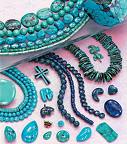 Turquoise is "stabalized" when it contains cracks and imperfections that would usually cause it to break autonomously when cut into jewelry stones. It is hardened or "stabalized" by injecting polyresin into the stone nether high pressure. Often colour enhancers are likewise injected into stabilized turquoise to make the colors appear brighter.
Turquoise is "stabalized" when it contains cracks and imperfections that would usually cause it to break autonomously when cut into jewelry stones. It is hardened or "stabalized" by injecting polyresin into the stone nether high pressure. Often colour enhancers are likewise injected into stabilized turquoise to make the colors appear brighter.
Possibly 80 to 90% of the turquoise used in indian jewelry has been stabilized. This isn't necessarily a bad matter. In this process, a solid piece of turquoise is used, and it is simply enhanced with resin where there are nearly invisible tiny cracks. This process strengthens the turquoise, and ways if you lot accidentally bump your turquoise ring on the java table, or drop your turquoise necklace on pavement, the stones aren't probable to break.
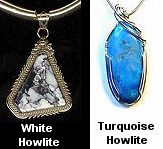 "White Buffalo" turquoise isn't rare, and in fact, it isn't turquoise at all. It is a cheap white rock called howlite. Howlite is also frequently dyed a light blueish and marketed equally turquoise.
"White Buffalo" turquoise isn't rare, and in fact, it isn't turquoise at all. It is a cheap white rock called howlite. Howlite is also frequently dyed a light blueish and marketed equally turquoise.
Heishi strung shell or rock beads should be regular in cut and smooth to the bear on. Fine Santo Domingo heishi feels like liquid when run through the fingers. Imported heishi volition often have rough edges, or non exist uniform in size.
The to a higher place two sections are more indicators of quality rather than ethnicity of the artist. Some native american artists use low quality or imported materials, too.
Jewelry prices
Today, it is estimated up to 70% of the jewelry marketed in the United states of america every bit "authentic handcrafted indian jewelry" is actually strange or factory made. There is often very little difference in craftsmanship or quality, but there is a large difference in price.
Genuine handmade Indian jewelry is often expensive. Mechanically produced or imported products made with lower labor costs may toll considerably less. If information technology is important to you that the piece is handcrafted by an american indian, and the price seems too skilful to be truthful – it probably is!!
Imported or mass produced silver jewelry will ordinarily cost about i/3 to i/2 of what a comparable slice that is handmade by a tribal member will price.
Native American or Indian Made
Past police force, any detail sold as Indian or Native American-made, must be the cosmos of an individual who is a member of a state or federally recognized indian tribe or tribally certified as an Indian artisan. Ask the seller to certify that the particular was Indian fabricated with a Certificate of Authenticity. It is a felony to forge this certificate.
Jewelry dealers
Buy from an established dealer who will provide a guarantee of authenticity and who will exist bachelor later to respond to any questions or complaints you may take almost your buy.
Obtain a receipt that includes all pertinent information nigh the origin and value of your buy.
Indicators the creative person is really native american
Information technology is very easy for people to misrepresent themselves on the Web, and "playing Indian" is unfortunately mutual.
If the web site or individual artist self-identifies every bit Indian, is tribal affiliation identified? Is the word used to identify the tribe accurate? Is it spelled correctly?
For example, a person who identifies simply as "Native American" or "American Indian" leaves much open to question since most Native peoples identify themselves in connexion to a item tribe rather than nether general terminology.
Tribal identification is often very specific. For case, rather than identifying simply under the "grab-all" name of Sioux, people who have this tribal affiliation frequently are more specific nigh which Sioux identity, such equally Rosebud Sioux or Oglala Sioux, or self-identify as being Dakota, Lakota, or Nakota, and usually even more specifically inside each of these tribal groups.
Language, mail service-contact history, and culture are like only non identical for these tribes, and although they place closely with each other, each Sioux tribe is a unique entity. <br.
The term "Sioux" is not a traditional name for these tribes and not what they called themselves. Sioux was derived from a word used by one of their enemies to identify them, significant snakes, which was given to the French in colonial times. After the French word for snakes was shortened to Sioux and adopted past the US Government.
Members of whatever Sioux tribe will well-nigh likely exist specific when identifying their tribal affiliation. Navajo artists will frequently even give their clan relationships.
Under the Indian Craft Act of 1990, it is illegal to sell jewelry as "Indian jewelry" or "Indian fabricated" when it is not. If an detail is described as indian "style" or native american "design," or similar phrases, information technology is probably not made by a recognized member of a federally or country recognized indian tribe.
Indian Arts and Crafts Association (IACA)
For more than twenty years, the Indian Arts and Crafts Association (IACA) has promoted authentic Native American arts. This non-profit Association was formed in 1974 past a group of dealers who knew that cheap imitations and imports were undermining America's only indigenous art form. Headquartered in Albuquerque, New United mexican states, IACA now has more than than 700 member artists, wholesale and retail dealers, museums and collectors throughout the Usa and in five foreign countries.
IACA maintains a Buyer's Guide to assist buyers locate artists and dealers of authentic arts and crafts.
RELATED LINKS ON THIS SITE:
Hopi argent jewelry is a modern arts and crafts
Common Indian Symbols used in Indian jewelry and their generally accepted meaning
Native American Jewelry Art
Turquoise, the fallen Sky rock
The differences between Navajo, Zuni, Hopi, and Santo Domingo jewelry styles
What is sterling silver, anyhow?
EXTERNAL LINKS:
Indian Arts and Crafts Association
The History of American Indian Jewelry
How the Quality of Turquoise Affects Its Employ in Jewelry
The Indian Arts and crafts Human activity of 1990
Prairie Edge Art Gallery
A reputable art gallery in Rapid City, S Dakota, that has a lot of high quality beadwork made past Lakota Sioux tribal members.
Source: https://www.aaanativearts.com/how-do-i-know-if-indian-jewelry-is-authentic-and-made-by-a-real-indian
0 Response to "Member of the Indian Arts and Crafts Association Turquoise Beads"
Post a Comment